The RMS Titanic lies on the ocean floor at a depth of about 12,500 feet, over 350 miles off the coast of Newfoundland. And it looks very different today than when it was first rediscovered in 1985.
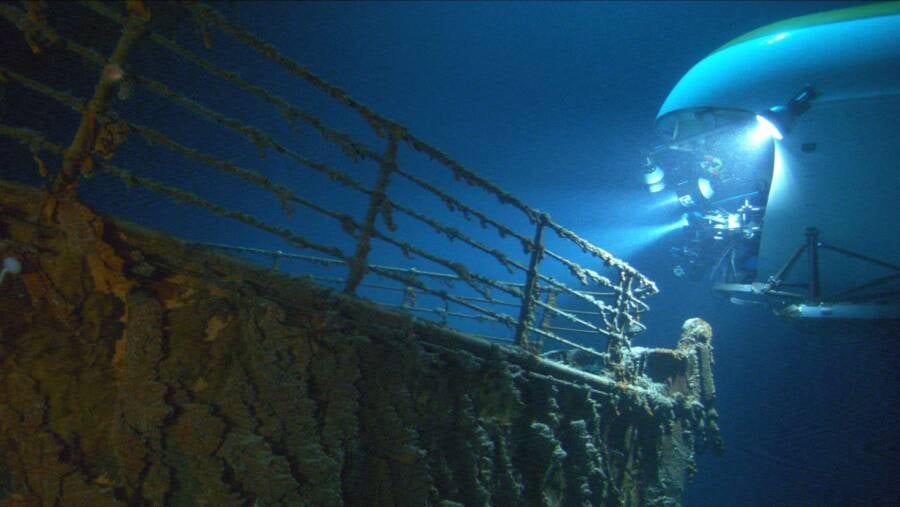
Maximum Film/Alamy Stock PhotoA submarine explores the RMS Titanic wreck in 2003.
The RMS Titanic, once hailed as an “unsinkable” marvel, has laid on the floor of the North Atlantic Ocean for over a century.
The doomed ship first set sail on April 10, 1912, from Southampton, England, carrying about 2,240 people on its maiden voyage. Just days into the journey, the ship fatefully collided with an iceberg, sinking in the early hours of April 15, 1912, and claiming about 1,500 lives.
The wreck remained elusive for decades until its rediscovery in 1985 by a French-American expedition, sparking many subsequent explorations. These missions have revealed the Titanic’s significant deterioration and have led to the collection of thousands of valuable artifacts.
Today, ongoing expeditions focus on documenting the wreck before it disappears entirely, providing a poignant glimpse into the history of one of the world’s most infamous maritime disasters.
How The RMS Titanic Ended Up On The North Atlantic Ocean Floor
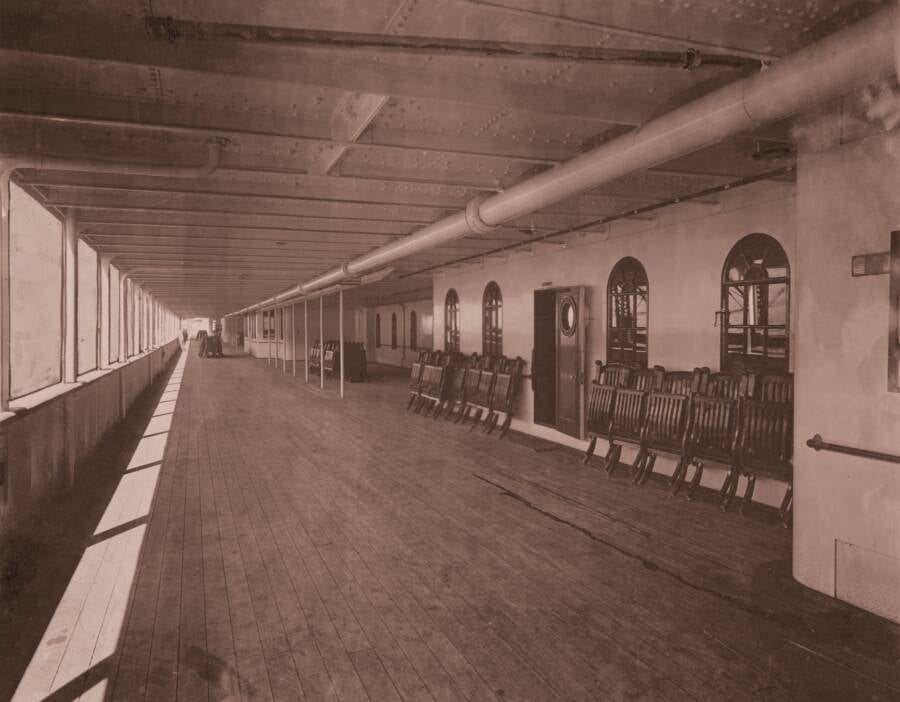
mccool/Alamy Stock PhotoThe Titanic’s promenade deck, pictured before the ship fatefully hit an iceberg. Circa 1912.
The RMS Titanic began its fateful voyage on April 10, 1912, departing from Southampton, England, for New York City. The Titanic’s reputation as a luxurious and massive ocean liner led 2,240 people to board the famous vessel for its maiden voyage across the Atlantic Ocean.
After four days at sea, the ship crashed into an iceberg about 400 miles east of Newfoundland. Shortly thereafter, in the early morning of April 15, 1912, the ship sank into the frigid waters, taking over 1,500 souls with it.
In total, only 706 people survived the horrifying disaster. In 2009, Millvina Dean, the last Titanic survivor, who was only two months old at the time of the sinking, died — leaving the RMS Titanic disaster gone from living memory from those who personally experienced it.
Because the ship went down in the middle of the ocean, it was long unknown exactly where the ship met its fate. In the years following the disaster, many expressed interest in finding and salvaging the ship, including the wealthy Astor family, whose family member, John Jacob Astor IV, died in the disaster. Various organizations used technology, like sonar systems and submarines, to try to find the wreck.
Then, in 1985, a joint French-American expedition made a breakthrough.
The First Expeditions To The RMS Titanic Wreck
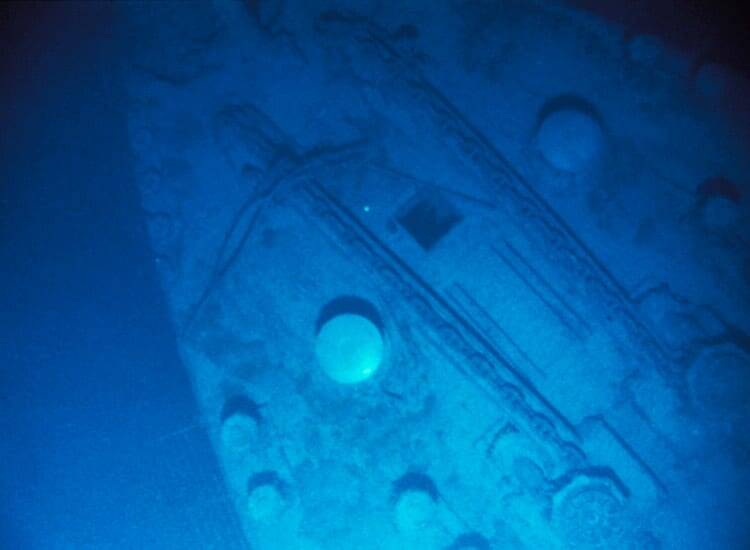
Woods Hole Oceanographic InstitutionOne of the first images of the RMS Titanic wreck, showing the port side of the bow.
In the 1960s and 1970s, there were several failed attempts to locate the RMS Titanic wreck. Before the site had even been rediscovered, search teams were already proposing potential solutions for how they would bring the ship to the surface, including some outlandish methods like filling the ship with ping pong balls or tons of Vaseline.
Even the Walt Disney Company got in on the hunt for the Titanic, proposing the use of an aluminum submersible to find the wreck — a viable option that was later abandoned due to the hefty financial cost.
In 1980, a Texas oil tycoon named Jack Grimm funded a series of expeditions to the location where the Titanic supposedly sank. Although he did not actually discover the wreck, his mapping helped pave the way for the expedition that would later uncover the ship.
In July 1985, a search party comprised of the Woods Hole Oceanographic Institution (WHOI) and the French National Institute of Oceanography (IFREMER) began their own expedition with two ships, the Knorr and Le Suroit, and two underwater vehicles, Argo and SAR.
At about 1 a.m. on Sept. 1, 1985, the crew found one of the Titanic’s boilers over 12,400 feet below the surface. It was the first time any part of the ship had been seen in 73 years. Before long, the crew found the rest of the wreckage and revealed that the ship was split into two pieces, just like many survivors had testified, only to have their claims dismissed. The stern was notably in far worse condition than the bow.
“It’s been transformed into another ship,” Robert Ballard, an American oceanographer and leader of the expedition, told the Los Angeles Times. “It has the vestiges of the Titanic, but it’s now a ship of the deep.”
The news of the discovery reverberated across the world: Finally, the most famous shipwreck in history had been found in the North Atlantic.
A year later, the first manned expedition to the Titanic wreck took place. While search crews explored the wreckage in the DSV Alvin, an underwater robotic camera took pictures of the ship. Several fixtures, bathrooms, and public rooms were found in relatively good condition.
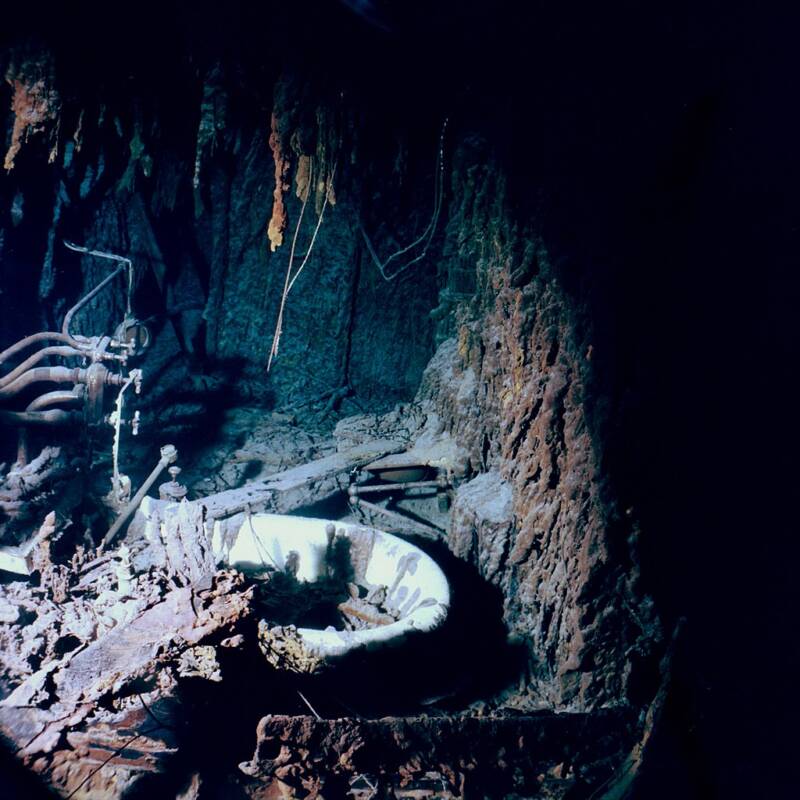
Public DomainThe bathroom of Captain Edward J. Smith.
Since the wreck’s discovery in 1985, numerous expeditions have taken place. A private American company called RMS Titanic, Inc. has salvaged over 5,000 artifacts from the wreck over the years since 1987, including everything from sheet music to pieces of china to items of clothing to chandeliers to pieces of the doomed vessel itself. Many of these items have been put on display in various permanent and touring exhibitions.
No human remains have ever been found in or near the Titanic.
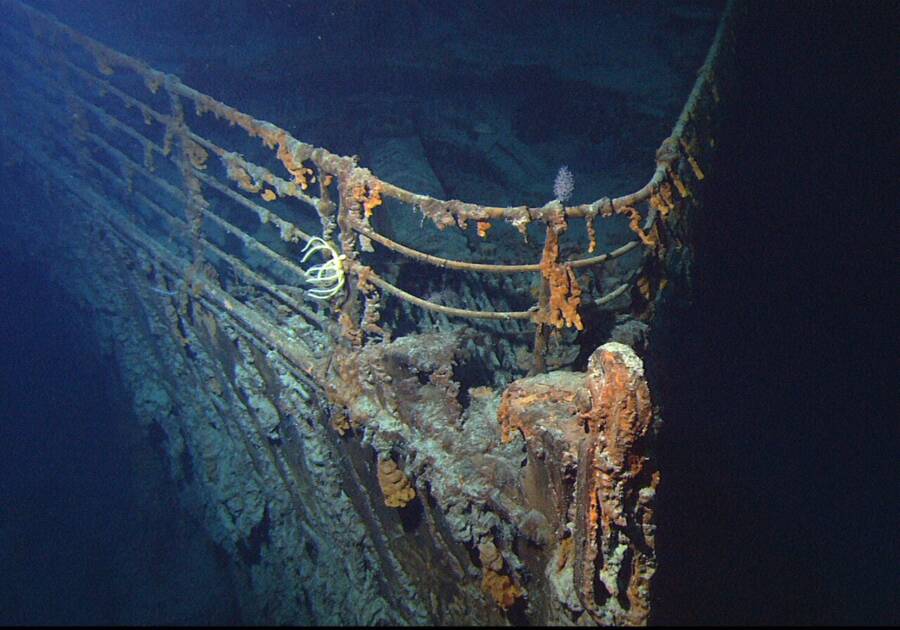
Public Domain A photo of the Titanic’s bow in 2004.
Today, expeditions to the RMS Titanic wreck are routine, with organizations returning regularly to monitor the degradation of the site.
Recent Trips To The Titanic Wreck
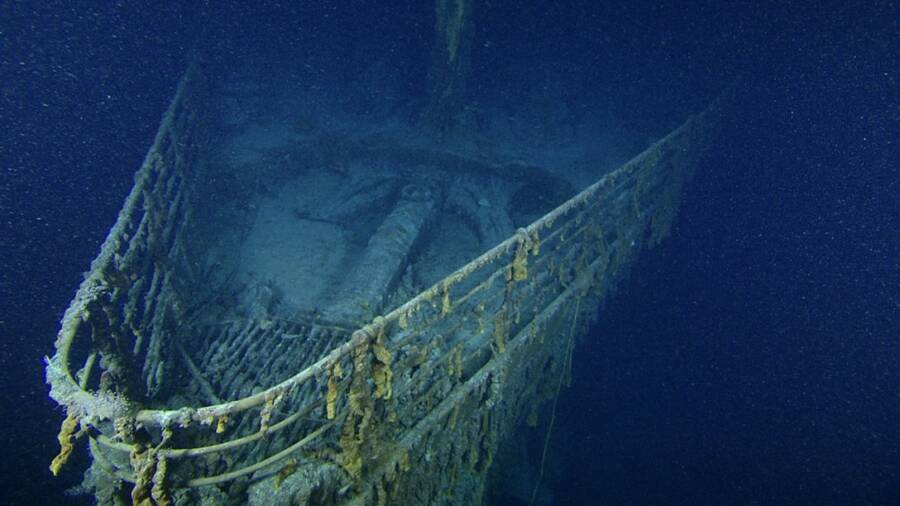
RMS Titanic, Inc.The Titanic’s bow in 2010.
By April 2012, on the 100th anniversary of the ship’s sinking, the RMS Titanic qualified for protection under a UNESCO convention. Since then, journeys to the wreck have been more focused on preserving and documenting the ship rather than extracting artifacts.
In 2019, footage from a manned expedition was compiled into a documentary, Back to the Titanic, which aired on National Geographic. The crew from the expedition captured the first 4k footage of the ship to take a closer look at its decay. In May 2023, the first full-sized digital scan of the wreck was created, thanks to deep-sea mapping, giving researchers a better glimpse at what happened to it as it sank.
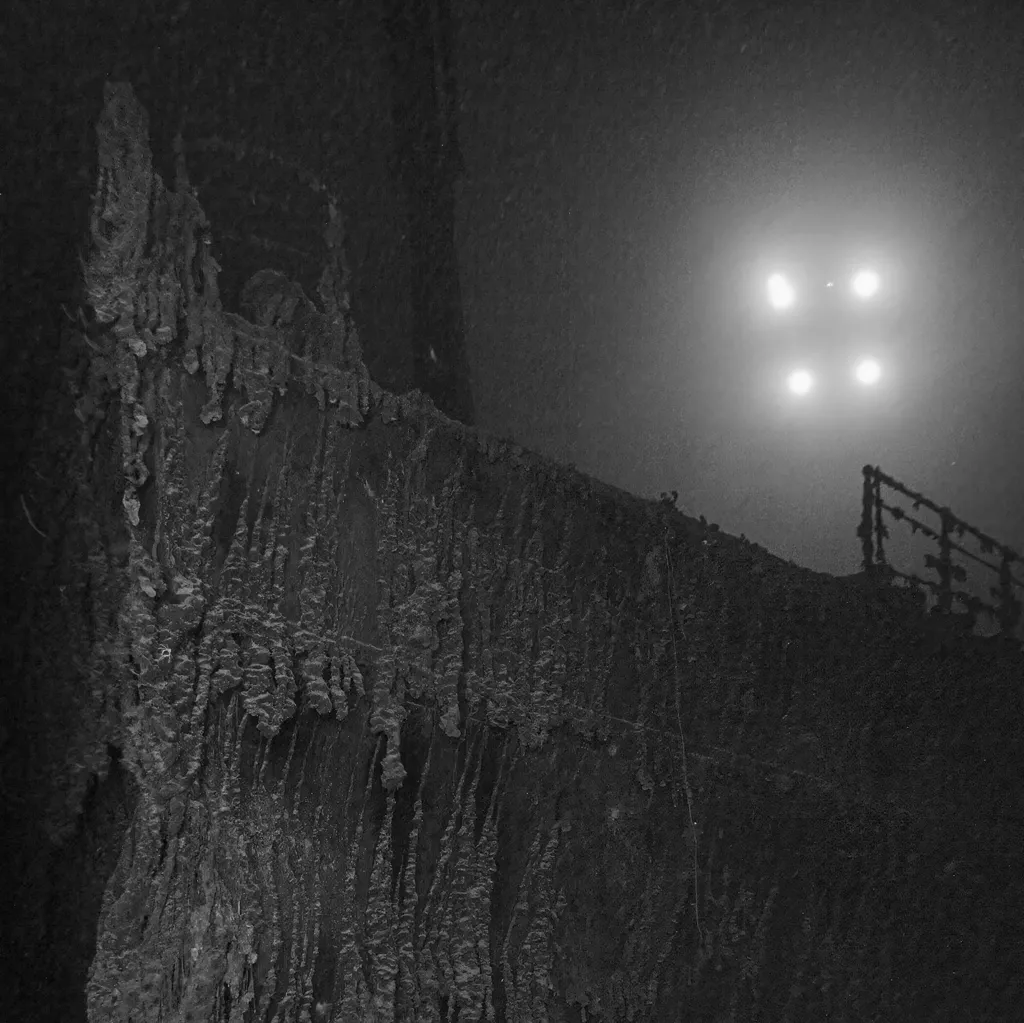
RMS Titanic, Inc.Bacteria are eating away at the rust of the Titanic.
However, other expeditions to the wreck have focused more on tourism than research, sometimes to disastrous results.
Around July 2021, the company OceanGate began providing commercial tours to the site in its submersible, called the Titan, which cost $250,000 per person. The company suspended operations after the Titan, carrying five people, including the OceanGate CEO Stockton Rush, imploded near the wreck on June 18, 2023 — killing everyone on board.
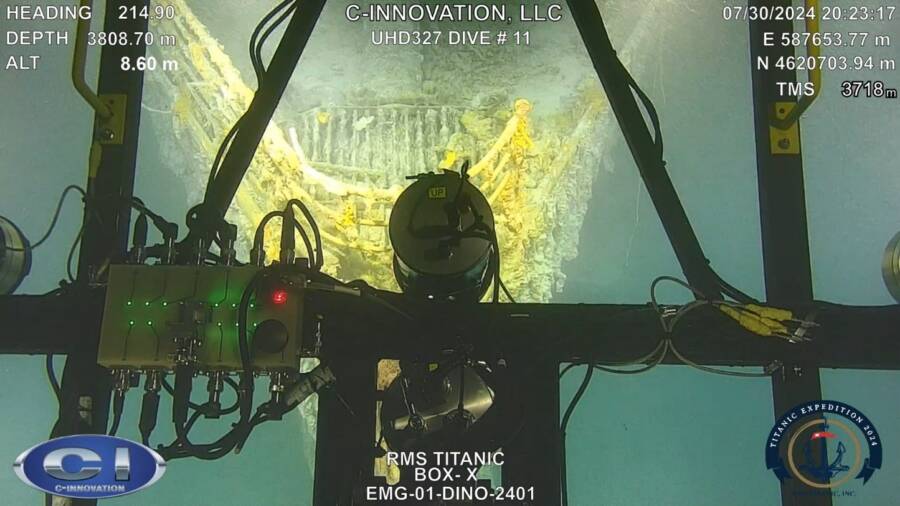
RMS Titanic, Inc.Footage from a 2024 Titanic expedition, showing a missing piece of the railing on the ship’s wreck.
One of the most recent expeditions to the Titanic wreck occurred in July 2024. The RMS Titanic, Inc. explored the ship for the first time in 14 years, utilizing high-tech camera systems, sophisticated remotely operated vehicles, and other cutting-edge technology.
One of the greatest accomplishments from the 2024 expedition was the rediscovery of the Diana of Versailles, a bronze statue that was once perched in the first-class lounge and featured in photos of the ship. Additionally, the crew discovered that a piece of the bow’s railing had collapsed, an eerie reminder of how much the ship has decayed.
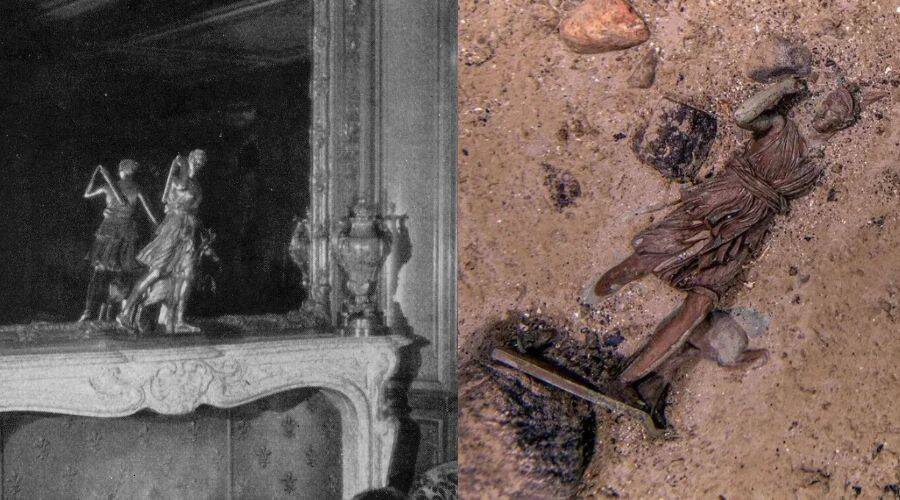
RMS Titanic, Inc.The Diana of Versailles as it stood in the first-class lounge on the Titanic — and on the ocean floor.
Recent journeys to the Titanic have revealed an unfortunate truth: The Titanic wreck is not likely to exist much longer. Its degradation by bacteria and the ocean’s high salt content has made the ship unstable and prone to collapsing. While it is unclear when the ship is expected to collapse entirely, experts estimate it can happen as early as 2030. As for when the ship will fully disappear, that might take centuries.
With no plans to raise what remains of the RMS Titanic and with all of its survivors having passed on, the ship’s legacy will endure only through the preserved stories and the images captured by explorers.
After reading about the RMS Titanic wreck, learn about other famous shipwrecks. Then, go inside the strangest Titanic conspiracy theories.





